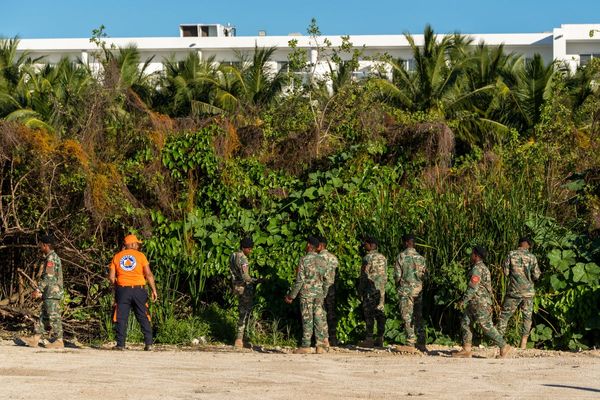A housing development on Hobart's eastern shore for 2,500 homes, described by council as "the most significant development in Australia", has hit a major hurdle but could still proceed with help from the state's planning minister.
The Skylands development at Droughty Point has been described by council officers as transformative "in terms of its potential to impact on the character of a capital city".
The project is unusual in that it is a significant parcel of undeveloped land — about 240 hectares — and close to the CBD of a capital city. It is about a 25-minute drive to Hobart's city centre.
The land is privately owned by the Carr and Lilly families, who engaged urban design firm DPZ to come up with the development design.
The proponents wanted the Clarence City Council to lift a restriction on building — known as the urban growth boundary — from 70 metres up the hillside to 110 metres, but that has been knocked back at a council meeting on Monday night.
Most submissions opposed
A council report said the urban growth boundary was set at 70 metres partly for aesthetic reasons but also because of the limits of reservoir water at the time.
In the Skylands master plan, 700 houses — covering 58 hectares — would be built above the boundary line with a 57-hectare park running along the ridge.
Howrah resident Kylie Holland from the Friends of Tranmere and Droughty Point Peninsula, said residents did not want housing that far up the hill.
"It's important to remember that our group is not against development," she wrote in a submission.
"We want a development that fits within the urban growth boundary, and embraces the wide-open natural spaces that Tasmania is known for around the world.
"In keeping with surrounding greater Hobart hilltops, we want to maintain the skyline as a reserve and encourage regeneration of the hilltop and we want to maintain our pristine waterways around the peninsula."
Of the 800 people who responded to the plans, 64 per cent were opposed and 23 per cent in favour.
Droughty Point was identified as having the potential for 3,000 new dwellings in the 30-year Greater Hobart Plan, which considered ways of adding 60,000 new residents to the city without extending the urban growth boundary.
Extending the boundary would require approval of Planning Minister Michael Ferguson.
Council rejects expansion request
At a meeting on Monday, the majority of councillors voted for an alternative motion by councillor Bree Hunter to refuse the application.
"I like to support visionary ideas and innovation," Cr Hunter said.
"[But] after days, weeks, months and even years of considering the Skylands proposal, I'm not comfortable with putting my name to its approval as it currently stands."
Cr Hunter said the master plan failed to address a lack of transport options in the area, sought to increase density too far from essential services and had not consulted enough with the community.
"I don't doubt a lot of analysis has been done for the site, [but] I have not been convinced that the urban growth boundary needs to be changed in this particular location … to accommodate 800 additional dwellings."
Tasmania 'in desperate need' of housing development, mayor says
Mayor Brendan Blomeley and councillors Walker and Hulme voted against the alternative motion.
"I'm disappointed that tonight we are discussing an alternate motion for refusal and not … the officer's recommendation to endorse the Skylands masterplan request to the planning minister to amend the urban growth boundary."
"My reason is simple – Tasmania is in desperate need of this type of truly transformational design and development.
"We simply cannot continue with the familiar post-1970s sub-urbanism that has dominated the growth of Greater Hobart."
'It would have been magnificent'
Proponent Greg Carr told ABC Radio Hobart that the council decision was "a tragedy".
"I say that because it has taken away the opportunity to help the housing crisis and we were going to give 34 per cent of our land to the public," he said.
"Revegetated hill tops, sweeping green corridors, it would have been magnificent."
Mr Carr said he and family members had spend hundreds of thousand of dollars on the proposal but would now revert to developing the land block by block as they had been, at a rate of around 10 houses a year.
He did not rule out appealing to the minister but said that decision had not yet been made.
If the Skylands development proceeded, six neighbourhoods would be built over nearly 30 years, in five-year stages, with 5 per cent social housing.
Urban designers DPZ said they were relying on a "new urbanism" concept, focusing on walkability, mixed housing and density, and high-quality architecture.
A council report said it constituted a new approach to residential development in Tasmania.
"Over the last three decades, other Australian states have made significant efforts to improve the quality of urban design and have introduced important urban design codes … Tasmania has made no progress."
Clarence has the lowest-density of Hobart's four council areas, with 93 per cent low density compared with 67 per cent in the city of Hobart.
In its design, DPZ argued the nature of the neighbourhoods – and incorporating green space – meant there was no option but to expand beyond the urban growth boundary.
Decision 'astonishing' and 'extremely disappointing'
Construction and housing minister Guy Barnett said he found the decision "extremely disappointing".
"For the life of me I do not understand why the Clarence City Council made such a decision," he said.
"You've got 2,500 homes that can be built on that property.
"The government will now be taking advice and we will be responding in due course based on that advice."
In a statement, Planning Minister Michael Ferguson said the government was "very disappointed in Clarence City Council's astonishing decision to refuse to endorse" the plan.
"Unfortunately, this is yet another occasion where, for whatever reason, the elected members of a council have voted against the expert advice of their own planning department.
"At a time when we need to deliver as many houses for Tasmanians as we can, this is an extraordinary vote against common sense, good planning, and due process.
"It is astonishing that such a large-scale, complex proposal should be dismissed by the elected members of a council rather than being allowed to be properly considered on its merits by the independent Tasmanian Planning Commission through the standard planning scheme amendment process, which includes public exhibition and public hearings.
He said the government supported the right of proponents "to have their proposals considered through an appropriate assessment process".
"We will now seek advice on how we can help that occur for the Skylands proposal."







